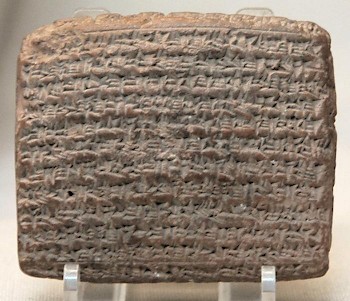ABC 4 (Late Years of Nabopolassar)
The Chronicle Concerning the Late Years of Nabopolassar (ABC 4) is one of the historiographical texts from ancient Babylonia. It deals with the wars of the Babylonian king Nabopolassar and his crown prince Nebuchadnezzar against nations that were, just like the Babylonians, interested in seizing parts of the declining Assyrian Empire.

This chronicle is the last part of one large text that began with the Early Years of Nabopolassar Chronicle (ABC 2) and continued with the Fall of Nineveh Chronicle (ABC 3). This text is inscribed on a small tablet, BM 22047 (96-4-9, 152), which, like Chronicle 2, 6, 9, and 15, has the shape of a Neo-Babylonian business document. It measures 45 mm long and 54 mm wide. The text is in splendid condition, so that only a few words are missing.
For a very brief introduction to the literary genre of chronicles, go here. The translation on this webpage was adapted from A.K. Grayson, Assyrian and Babylonian Chronicles (1975) and Jean-Jacques Glassner, Mesopotamian Chronicles (Atlanta, 2004).
[1] The eighteenth year of Nabopolassar (608/607): In the month Ulûlu the king of Akkad mustered his army and
[2] following the bank of the Tigris to the mountains of Bit-Hanunya
[3] in the district of Urartu, he went up. He set fire to the cities and
[4] plundered them extensively. In the month Tebêtu the king of Akkad went home.
[5] The nineteenth year (607/606): In the month Simanu the king of Akkad mustered his army and
[6] Nebuchadnezzar, his eldest son, the crown prince,
[7] mustered his army. They marched to the mountains of Za[...].
[8] The king of Akkad left the prince and his army there while he returned to Babylon in the month of Du'ûzu.
[9] After his departure, Nebuchadnezzar did battle at Biranati, situated in the mountains,
[10] captured Biranati, set it on fire, and took many prisoners.
[11] He conquered all of the mountains as far as the district of Urartu.
[12] In the month Ulûlu the prince returned to Babylon. In the month Tašrîtu the king of Akkad mustered his army and
[13] marched to Kimuhu, which is on the bank of the Euphrates.
[14] He crossed the river, did battle against the city, and in the month Kislîmu he captured the city.
[15] He sacked it and stationed a garrison of his in it. In the month Šabatu he went home.
[16] The twentieth year (606/605): The army of Egypt marched[17] against the garrison of Kimuhu
[17] which the king of Akkad had stationed inside. For four months,
[18] they laid siege to the city, captured it, and defeated the garrison of the king of Akkad.
[19] In the month Tašrîtu, the king of Akkad mustered his army, marched along the bank of the Euphrates, and
[20] pitched camp in Quramatu, which is on the bank of the Euphrates.
[21] He had his army cross the Euphrates and they captured[22] Šunadiri, Elammu,
[22] and Dahammu, cities of Syria,
[23] and plundered them. In the month Šabatu the king of Akkad went home.
[24] The army of Egypt, which was in Karchemiš, crossed the Euphrates and
[25] against the army of Akkad, which was camped in Quramatu,
[26] it marched. They pushed the army of Akkad back so that they withdrew.
[27] The twenty-first year (605/604): The king of Akkad stayed home while Nebuchadnezzar, his eldest son
[28] and crown prince, mustered the army of Akkad.